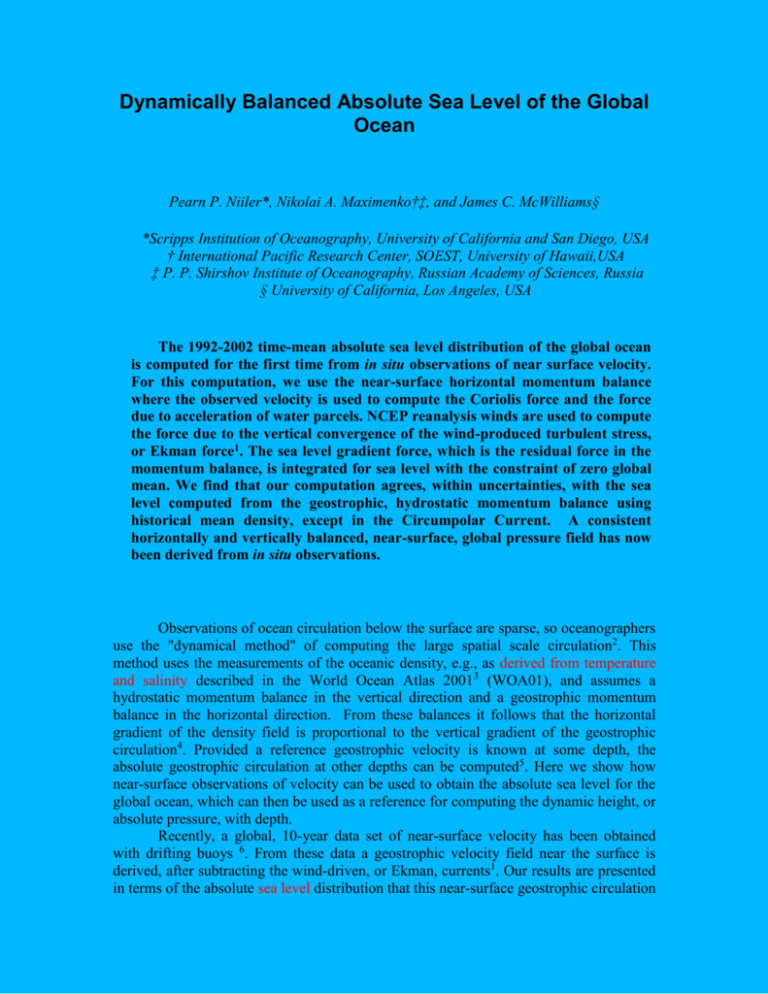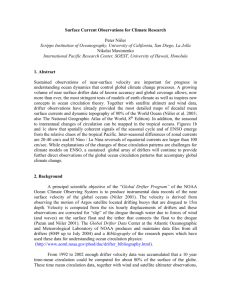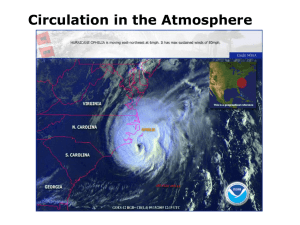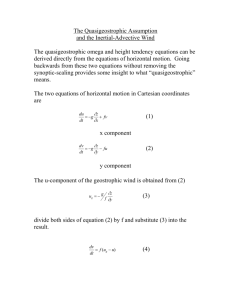“Dynamically Balanced Absolute Sea Level of the Global Ocean”
advertisement

Dynamically Balanced Absolute Sea Level of the Global
Ocean
Pearn P. Niiler*, Nikolai A. Maximenko†‡, and James C. McWilliams§
*Scripps Institution of Oceanography, University of California and San Diego, USA
† International Pacific Research Center, SOEST, University of Hawaii,USA
‡ P. P. Shirshov Institute of Oceanography, Russian Academy of Sciences, Russia
§ University of California, Los Angeles, USA
The 1992-2002 time-mean absolute sea level distribution of the global ocean
is computed for the first time from in situ observations of near surface velocity.
For this computation, we use the near-surface horizontal momentum balance
where the observed velocity is used to compute the Coriolis force and the force
due to acceleration of water parcels. NCEP reanalysis winds are used to compute
the force due to the vertical convergence of the wind-produced turbulent stress,
or Ekman force1. The sea level gradient force, which is the residual force in the
momentum balance, is integrated for sea level with the constraint of zero global
mean. We find that our computation agrees, within uncertainties, with the sea
level computed from the geostrophic, hydrostatic momentum balance using
historical mean density, except in the Circumpolar Current. A consistent
horizontally and vertically balanced, near-surface, global pressure field has now
been derived from in situ observations.
Observations of ocean circulation below the surface are sparse, so oceanographers
use the "dynamical method" of computing the large spatial scale circulation2. This
method uses the measurements of the oceanic density, e.g., as derived from temperature
and salinity described in the World Ocean Atlas 20013 (WOA01), and assumes a
hydrostatic momentum balance in the vertical direction and a geostrophic momentum
balance in the horizontal direction. From these balances it follows that the horizontal
gradient of the density field is proportional to the vertical gradient of the geostrophic
circulation4. Provided a reference geostrophic velocity is known at some depth, the
absolute geostrophic circulation at other depths can be computed5. Here we show how
near-surface observations of velocity can be used to obtain the absolute sea level for the
global ocean, which can then be used as a reference for computing the dynamic height, or
absolute pressure, with depth.
Recently, a global, 10-year data set of near-surface velocity has been obtained
with drifting buoys 6. From these data a geostrophic velocity field near the surface is
derived, after subtracting the wind-driven, or Ekman, currents1. Our results are presented
in terms of the absolute sea level distribution that this near-surface geostrophic circulation
maintains. The sea level distribution derived from the velocity field is compared with
those derived by the aforementioned use of the density field. Satellite-derived gravity and
altimeter data can also be used for computing the large-scale absolute sea level, and a
comparison with such data can be made soon7.
The global sea level derived by use of near-surface velocity observations and the
horizontal momentum balance (Fig.1) confirms the large-scale spatial patterns north of
40oS that have been derived by the "dynamical method". For comparisons we use
Reid's5,8,9 "adjusted steric height at 0 db" and the 3000 m relative steric height we
computed from WOA01 (Table 1). Nearly all differences of mean sea level across the
subtropical basins (columns 2 and 3 of Table 1) and between the subtropical highs and
sub-polar lows (column 4 of Table 1) with the three different methodologies agree within
9 cm. The exceptions are in the subtropical North Atlantic, which in our map is due to a
displacement to the east of the high sea level because of a strong, narrow, geostrophic
Azores Current not present in Reid's or WOA01's. The disparity between Reid's
computation and the other two in the Indian Ocean appears to be caused by the dearth of
data directly east of Madagascar. The root-mean-square dynamic heights at 3000 m
relative to our absolute surface value, in the basins north of 40oS, are 5.8, 7.2 and 7.2 cm
for Pacific, Atlantic and Indian oceans, respectively.
The largest differences between our sea level and the WOA01 3000 m-referenced
sea level occur in the Circumpolar Current System, south of 40oS (row 5 of Table 1). The
surface geostrophic velocity derived from the drifter data is also stronger than what is
obtained from WOA01 referenced to the float observations at 900 m depth10. We estimate
that the 3-basin average surface dynamic height difference from 60oS to 40oS referenced
to the floats is 155 cm, which implies an average zonal surface geostrophic current of 6.3
cm/sec. The sea level difference derived from drifter observations is 234 cm, or average
zonal current of 9.6 cm/sec. The winds in this southern ocean are persistently larger than
8 m/sec, with concomitant large surface waves; this is above the range for which drifter
slip calibrations were obtained6. We re-computed the absolute sea level for winds
observed by drifters less than 8 m/s (row 6 of Table 1), where average sea level
difference is reduced to 198 cm. This reduction indicates that the large winds and ocean
waves produce slip of drogues or displacements by the Stokes drift that need to be
directly measured in the Circumpolar Current to resolve the discrepancy among the sea
level estimates.
The sea level computed by the use of the horizontal momentum equation is
sensitive to the choice of the model of Ekman velocity VE, which accounts for about 50%
of the east to west sea level differences across the basins. Our model was derived1 by use
of density data11 and a limited drifter data set in the Pacific within 30o of the equator. An
independent test of the efficacy of the Ekman velocity model is shown in Figure 2, which
displays (f{VD – VS}) + k ( { dVD/dt }) (where VD and VS are drifter- and
altimetry-derived velocities) and (f{VE}) averaged in 5o latitude bands that exclude
regions 200 km from the basin boundaries. The Ekman velocity model in (1) achieves the
basin-scale vorticity balance within uncertainties. Our model of the Ekman current is
linear in wind speed and does not depend upon the upper-ocean stratification.
Observations and modeling of upper ocean currents call to question the validity of such a
simple approach on a global basis12, especially in high wind and wave conditions.
While the nonlinear effects of the oceanic mesoscale have been included in the
term {dV/dt} of (2), the momentum convergence due to surface gravity waves and their
effect on the momentum balance has not. Wave-momentum convergences can result in
wave forces that produce time-mean sea level signals at subpolar latitudes in excess of 10
cm13. The Stokes drift within several meters of the surface for 10 m/s winds is estimated
to be in excess of 30 cm/s in the direction of the wind13 and could well be the cause of the
increased slip of drifter drogues down wind. Neither of these effects was considered here,
but they must be in a more complete analysis.
As seen in Figure 3, the 3000 m-level absolute dynamic heights computed from
the difference of 0 in Figure 1 and the WOA01 3000 m relative steric level depict peakto-peak variations of 15 cm north of 40oS. These variations are comparable to the
uncertainty of the determination of sea level from (2), and large-scale geostrophic
circulations of less than 0.5 cm/s can maintain these dynamic height differences at depth
over the spatial scales exhibited. While large-scale, time-mean currents of less than 1
cm/s have been observed with floats14, they are beyond the accuracy of drifter
observations, the model for the Ekman force, or the sampling uncertainty for the mean
velocity in the presence of intense, upper-ocean, time-variable flows.
Besides providing an absolute sea level within 10-15% of the large-scale changes
across the major ocean basins, near-surface velocity observations also provide circulation
maps of high spatial resolution that cannot be obtained by any other method today. An
example is in the North Atlantic, geostrophic velocity (Fig. 4) that shows the Azores
Current arising with a clear connection to the Gulf Stream recirculation at 33oN, 46o W.
The Azores Current then flows eastward as a 100 km wide current. When it reaches the
southern part of the Gulf of Cadiz 3500 km to the east, its axis has moved northward by
about 100 km. Figure 4 also clearly depicts a strong, narrow current system that follows
the 1000 m depth contour around the Irminger and the Labrador basins.
Methods
The velocities are derived from ARGOS satellite observations of the
displacements of drifters with drogues centered at 15m-depth for the period October 1992
to October 2002, for which contemporaneous altimeter observations processed by Aviso15
are available. Niiler6 describes the construction and water-following capabilities of the
drifters, their deployment procedures, and the data processing. We average the drifter
positions and velocities over two inertial periods along the drifter track and then
interpolate to 6-hourly values. The 6-hourly velocity observations within 1º latitude x 1º
longitude boxes are ensemble-averaged to form a mean velocity.
The wind-driven, or Ekman, velocity is computed at 6-hourly intervals along the
drifter track from the empirically fit, complex-notation formula,1
VE = A |f|–1/2 W exp(i),
(1)
where VE = UE + iVE is the Ekman current at 15 m depth, A=710-7 s-1/2, f is the
Coriolis parameter and W = Wx + iWy is the NCEP reanalysis 10 m height wind
interpolated to each drifter track and exp(i) ( = 54º) represents the rotation of
the Ekman current to the right [left] of the wind vector in the northern [southern]
hemisphere. The ensemble average of the Ekman current is computed the same way as
the drifter current. The Ekman velocity VE is subtracted from the drifter velocity, VD, and
a drifter-sample time-mean (denoted by {.}), geostrophic velocity, {VG}, is derived. An
adjustment is then made for the time sampling bias of the drifters with altimeter-derived,
geostrophic velocity observations16, as now described.
The horizontal momentum equation for the 10-year time-averaged sea level, <>,
is
4
g<> = - f { VG - VS } { dV/dt },
(2)
where {dV/dt} is the drifter ensemble average of the acceleration following the drifter
motion and { VS } is the altimeter-derived, time-dependent, anomaly of geostrophic
velocity averaged over drifter observations. Over the 10-year, regularly sampled interval,
< VS > = 0. Since irregularly distributed drifter observations can be biased in time over
the 10-year period, the quantity { VG - VS } is the unbiased geostrophic velocity. A
solution, 0, for <> is found by fitting a surface through the finite-difference form of (2)
in the global least-square sense, with the constraint that the global average of 0 is zero
(Fig.1).
To estimate how well 0 corresponds to <>, a potential, , is evaluated from the
equation,
= k (0 <>),
(3)
with the same technique as used to construct a solution for 0. Substituting from (2) and
taking the divergence of (3) yields
2 = (f{ VG - VS }) + k ( { dV/dt }).
(4)
In the absence of errors, the right side of (4), or the curl of the right side of (2), must
vanish, but in practice this does not occur. The potential measures the error introduced
in to the solution 0 due to the fact that the right side of (2) is not curl-free. Solving for
in a global least-square to the derivatives defined in (3) is formally equivalent to solving
(4) with a normal boundary derivative specified by the normal component of the right
side of (3)9. The global root-mean-square value of is 6.5 cm, and the values for Pacific,
Atlantic and Indian oceans north of 40ºS are 7.8, 3.7 and 4.1 cm, correspondingly.
References
1. Ralph, E. A., and P. P. Niiler, Wind driven currents in the tropical Pacific, J. Phys.,
Oceanog., 29, 2121-2129, 1999.
2. Defant, A., Physical oceanography, Oxford, Pergamon Press, 729 pp.,
1961.
3. Conkright, M. E., R. A. Locarnini, H. E. Garcia, T. D. O'Brian, T. P.
Boyer, C. Stephens, and J. I. Antonov, World Ocean Atlas 2001:
Objective
analysis,
data
statistics,
and
figures,
CD-ROM
Documentation, National Oceanographic Data Center, Silver Spring,
MD, 17 pp., 2002.
4. Pedlosky, J., Geophysical Fluid Dynamics, 2nd Ed., Springler-Verlag, New York,
710pp., 1987.
5. Reid, J. L., On the total geostrophic circulation of the North Atlantic
ocean: flow patterns, tracers, and transports, Progr. Oceanogr., 33(1),
1-92, 1994.
6. Niiler, P., The World Ocean Surface Circulation. In: Ocean Circulation and ClimateObserving and Modeling the Global Ocean, Eds. J. Church, G. Siedler, and J. Gould,
Academic Press, London, 193-204, 2001.
7. Tapley. B. D., The gravity recovery and climate experiment (GRACE),
Supp. EOS Transactions of the AGU, 78(46), p.163.
8. Reid, J. L., On the total geostrophic circulation of the Pacific ocean: flow
patterns, tracers, and transports, Progr. Oceanogr., 39(4), 263-352,
1997.
9. Reid, J. L., On the total geostrophic circulation of the Indian ocean: flow
patterns, tracers, and transports, Progr. Oceanogr., 56(1), 137-186,
2003.
10. Gille, S. T., float observations of the Southern Ocean. Part I: Estimating mean fields,
bottom velocities, and topographic steering. J. Phys. Oceanogr., 33, 1167-1181, 2003.
11. Levitus, S., Climatological Atlas of the World Ocean, NOAA Prof. Paper
No. 13, U.S. Government Printing Office, 173 pp, 1982.
12. Large, W. G., J. C. McWilliams, and S. C. Doney, Oceanic vertical
mixing: a review and a model with a nonlocal boundary layer
parameterization, Rev. Geophys., 32(4), 363-403, 1994.
13. McWilliams, J. C., and J. M. Restrepo, The wave-driven ocean
circulation, J. Phys., Oceanog., 29, 2523-2540, 1999.
14. Davis, R. E., Preliminary results from directly measuring middepth
circulation in the tropical and South Pacific, J. Geophys. Res., 103(C11),
24,619-24,639, 1998.
15. Archiving, Validation, and Interpretation of Satellite Oceanographic Data (Aviso). In:
Aviso Handbook for Merged TOPEX/Poseidon products, 3rd ed., Toulouse, France,
1996.
16. Niiler, P. P., N. A. Maximenko, G. G. Panteleev, T. Yamagata, and D. B. Olson,
Near-surface Dynamical Structure of the Kuroshio Extension, J. Geophys. Res., 108,
doi:10.1029/2002JC001461, 2003.
17. Salmon, R. L., Lectures on Geophysical Fluid Dynamics, Oxford
University Press, 400 pp., 1998.
Table 1. Sea level differences across basins: (Reid5,8,9; WOA013; and this
study)
Ocean Basin
Pacific
Atlantic
Indian
(a) Southern
all data
(b) Southern
|W|<8 m/sec
Location of end points
30oN, 135oE-120oW
(85 cm; 80 cm; 86 cm)
30oN, 75oW-15oW
(55 cm; 50 cm; 35 cm)
Location of end points
18oS, 170oE-80oW
(57 cm; 64 cm; 47 cm)
30oS, 30oW-14oW
(40 cm; 37 cm; 44 cm)
20oS, 55oE - 35oS, 115oE
(40 cm; 61 cm; 59 cm)
60oS-40oS, 160oW-80oW 60oS-40oS, 40oW-20oE
(n/a; 110 cm; 210 cm)
(n/a; 140 cm; 222 cm)
(n/a; n/a; 168 cm)
(n/a: n/a; 200 cm)
Location of end points
30oN, 140oE-50oN, 165oE
(140 cm; 132 cm; 144 cm)
30oN, 75oW-60oN, 45oW
(133 cm; 137 cm; 121 cm)
60oS-40oS, 23oE-63oE
(n/a; 160 cm; 271 cm)
(n/a; n/a; 225 cm)
Figure Captions
Figure 1. 1992-2002 mean absolute sea level 0 obtained as described in this paper.
Contour interval is 10 cm. Sea level is computed from the values of <>
estimated according to (2) on 10 spatial grid with the condition of zero global
mean.
Figure 2. Meridional distributions of zonal mean (f{VD – VS}) + k ( { dV/dt })
(gray strips indicate values deviating from the mean by less than the standard
error) and (f{VE}) (mean profile and standard error bars are in black) averaged
over the Pacific (a), Atlantic (b), and Indian (c) oceans in 5o latitude bands that
exclude regions within 200 km of the basin boundaries.
Figure 3. Distribution of pressure anomaly (in dyn.cm) at 3000 m estimated from the
mean sea level shown in Figure 1 and dynamic topography relative to 3000 m
level calculated from WOA01. Contour interval is 20 cm for negative values
south of 400S and 5 cm elsewhere. Global mean value is subtracted. Negative
values are shaded.
Figure 4. The unbiased mean geostrophic velocity, {VG - VS }, at 15 m depth in the
North Atlantic with a 1/2o spatial resolution and averaged from October 1992 to
October 2002. Vectors larger than 5 cm/s are shown in red. 20 cm/s scales are
displayed in the upper left corner.











